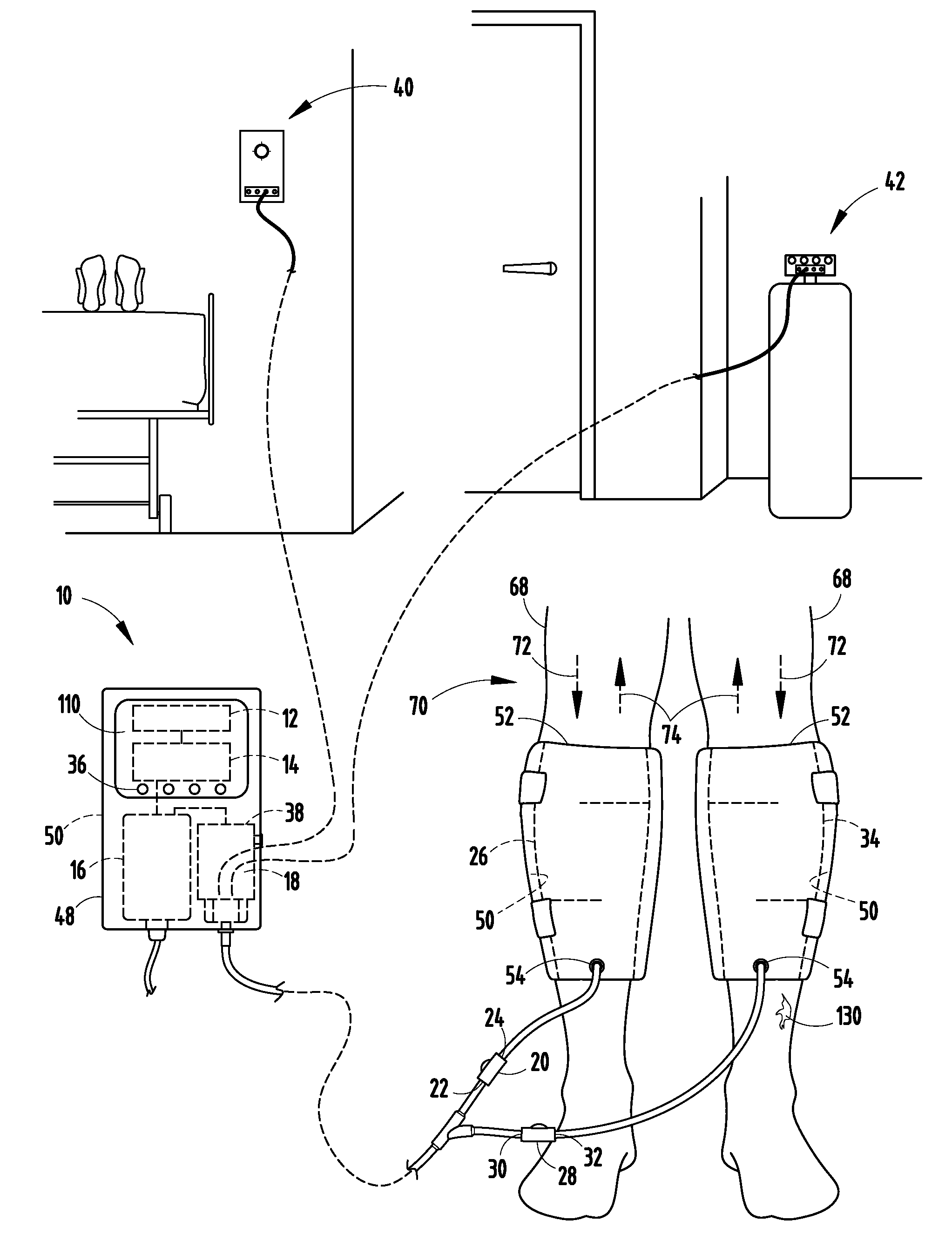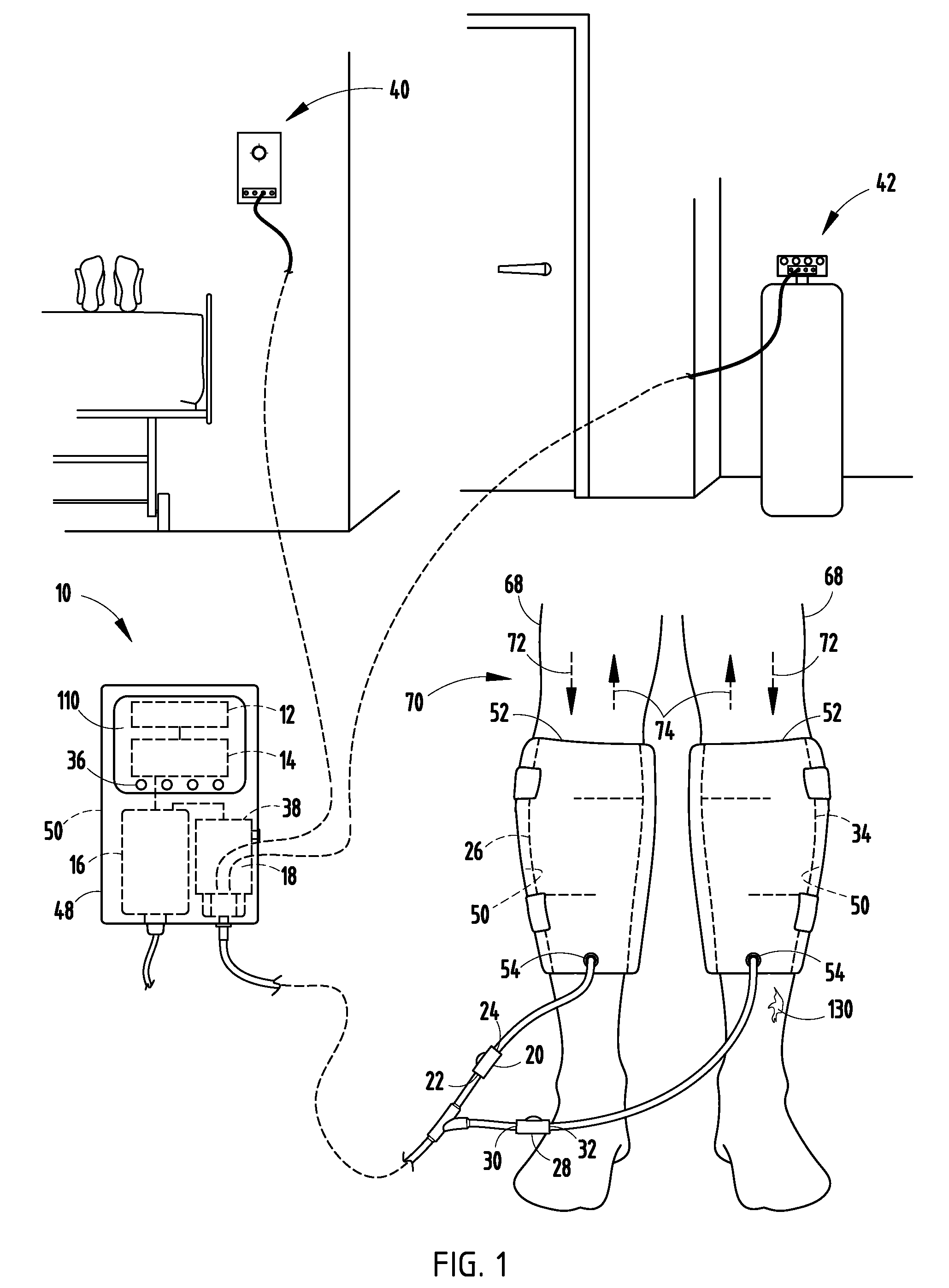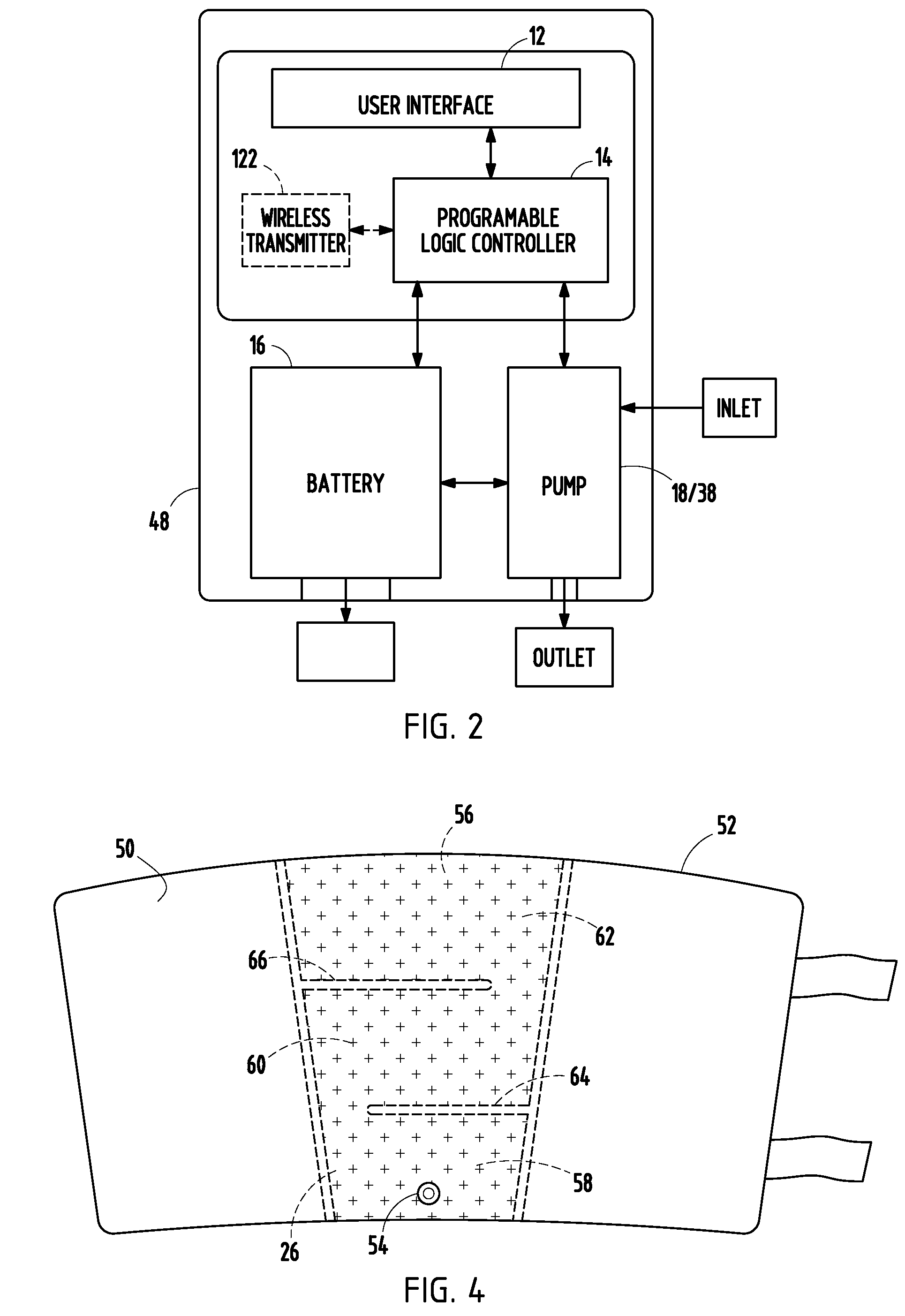[0018]More specifically, described herein is a compression device comprising a
user interface, a
programmable logic controller in electronic connection with the
user interface, a battery power source in electronic connection with the programmable logic controller, a source of fluidic pressure in electronic connection with the battery power source and the programmable logic controller, a first valve having at first port in fluidic connection with the source of fluidic pressure and a second port in fluidic connection with a first inflatable bladder, a second valve having a first port in fluidic connection with the source of fluidic pressure and a second port in fluidic connection with a second inflatable bladder. The programmable logic controller is programmed to cause a repeating sequence of inflating the first inflatable bladder by opening the first and second ports of the first valve, closing the first and second ports of the second valve, and activating the source of fluidic pressure, then after a first period of time, deflating the first inflatable bladder by deactivating the source of fluidic pressure, inflating the second inflatable bladder by closing the first and second ports of the first valve, opening the first and second ports of the second valve, and activating the source of fluidic pressure, waiting for a second period of time, then deflating the second inflatable bladder by deactivating the source of fluidic pressure. The user interface allows the user to select a mode that extends the life of the battery power source by selecting the first period of time and the second period of time such that the life of the battery will last for a desired time.
[0019]In addition, described herein is a compression device comprising a user interface, a programmable logic controller in electronic connection with the user interface, a power source in electronic connection with the programmable logic controller, a source of fluidic pressure in electronic connection with the power source (if the electronic connection is needed) and the programmable logic controller, a first valve having at first port in fluidic connection with the source of fluidic pressure, a second port in fluidic connection with a first inflatable bladder, and a third port in fluidic connection with a second valve. The second valve has a first port in fluidic connection with the source of fluidic pressure, a second port in fluidic connection with a second inflatable bladder, and a third port in fluidic connection with the first valve. The programmable logic controller is programmed to cause the repeating sequence of: (a) inflating the first inflatable bladder by opening the first and second ports of the first valve, closing the third port of the first valve, closing the first and second ports of the second valve, and activating the source of fluidic pressure; (b) after a first period of time, deflating the first inflatable bladder and partially inflating the second inflatable bladder by deactivating the source of fluidic pressure, closing the first port of the first valve, opening the third port of the first valve, opening the third port of the second valve, and opening the second port of the second valve; (c) further inflating the second inflatable bladder by closing the first, second, and third ports of the first valve, opening the first and second ports of the second valve, closing the third port of the second valve, and activating the source of fluidic pressure; and (d) after a second period of time, deflating the second inflatable bladder and partially inflating the first inflatable bladder by deactivating the source of fluidic pressure, closing the first port on the second valve, opening the third port of the second valve, opening the third port of the first valve, and opening the second port of the first valve. In this manner, the
fluid pressure within the first inflatable bladder, when allowed to
deflate, partially inflates the second inflatable bladder (and vice-versa), thus requiring less work by the source of fluidic pressure and the power source.
[0023]In addition, described herein is a method of compressing a body part comprising the steps of: (a) presenting a compression device; (b) at least partially surrounding a body part of a living being with the compression device; and (c) using the source of fluidic pressure to inflate the inflatable bladder. The compression device comprises an inflatable bladder. The inflatable bladder comprises an inlet port and an interior volume, the inlet port being in fluidic communication with the interior volume and a source of fluidic pressure. The interior volume comprises a first chamber, a second chamber, and a third chamber, the first chamber in fluidic communication with the second chamber, and the second chamber in fluidic communication with the third chamber. A first divider partially separates the first chamber from the second chamber. A second divider partially separates the second chamber from the third chamber. This method can also be used to treat or prevent a
chronic wound by enhancing circulation (in addition to the other purposes described above).
[0025]In addition, described herein is a method of compressing a body part comprising the steps of: (a) presenting a compression device; (b) at least partially surrounding a body part of a living being with the compression device; and (c) using the source of fluidic pressure to inflate the inflatable bladder. The compression device comprises an inflatable bladder. The inflatable bladder comprises an inlet port in fluidic communication with a source of fluidic pressure. The inflatable bladder further comprises a first chamber, a second chamber, a third chamber, a first
check valve, and a second
check valve. The first chamber is in fluidic communication with the inlet port and the second chamber, through a first
check valve. The second chamber is in fluidic communication with the third chamber, through a second check valve. The first check valve and the second check valve are capable of causing the first chamber to inflate fully before the second chamber inflates fully, and the second chamber to inflate fully before the third chamber inflates fully. This method can also be used to treat or prevent a
chronic wound by enhancing circulation (in addition to the other purposes described above).
[0028]In addition, herein described is a method of treating a wound comprising the steps of: (i) presenting a body part of a living being, the body part having a wound and an area adjacent to the wound; (ii) presenting a compression device comprising an inflatable bladder in fluid communication with a source of fluidic pressure; (iii) at least partially surrounding the area of the body part adjacent to the wound with the compression device; and (iv) using the source of fluidic pressure to inflate the inflatable bladder to increase circulation in the body part.
 Login to View More
Login to View More  Login to View More
Login to View More 


